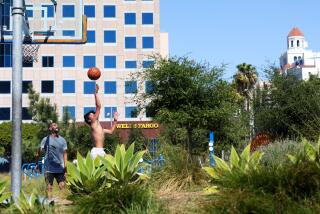Plan to Turn Breakers Into Home Has Support but Many Prefer It as a Hotel
- Share via
LONG BEACH — Historical preservationists and local leaders say they are glad to see that the stately Breakers Hotel will become a retirement home rather than be demolished.
Ideally, however, they would like to see the Breakers become the grande dame of Long Beach hotels among such youthful beauties as the Ramada Renaissance, Hyatt and new Sheraton.
“I would hope some day it could be restored to its former glory,” said Nancy Latimer, chairwoman of the city Planning Commission and a founder of the Coalition to Preserve Historic Long Beach. “I still believe there is a place for a small, historic hotel in this city.”
The developers say increasing competition from major hotel chains precludes reopening the Breakers as a hotel. They say their plan to convert the 15-story building to senior citizen housing is a way to save one of the city’s most historic buildings.
The Times reported Wednesday that the Breakers, which was shut last January because of financial difficulties, is being bought by developers who plan to sink more than $2.3 million into the 242-room hotel to make it safe from earthquakes and accessible to older people.
The Sky Room, in which couples swayed to orchestra dance music in the 1930s and 1940s overlooking a panoramic ocean view, would be reopened to the public for gourmet dining. The developers also say they would like to make space available for a child-care center to serve the needs of working parents in the community and allow seniors to interact with children.
The building is expected to reopen next May, said Richard Bookman, president of Senior Living Development Inc., who is undertaking the project with Frank J. Haffner, president of Senior Living Communities Inc. The firms are subsidiaries of Shamrock of California Inc., based in Burbank.
The developers are buying the building from First Interstate Bank of California, which had taken ownership from Breakers Associates. Neither the buyers nor seller would discuss the price or terms.
With the Jergins Trust Building and Pacific Coast Club being demolished after protracted fights, historical preservationists have been concerned that the Breakers might be next.
“It’s got historical value and architectural value and we don’t want to lose it,” said Renee Simon, chairwoman of the historical preservation coalition.
Donald L. Westerland, chairman of the city Redevelopment Agency, said the senior-citizen housing plan could provide a sound financial base to save the landmark.
“The longer the building lies vacant, the more it concerns me,” he said. The Breakers must be saved “as an architectural signature on our landscape.”
Doug Otto, founder and immediate past president of the Long Beach Heritage Foundation, said studies showed during the fight to save the Pacific Coast Club that there is a strong market in Long Beach for quality housing for senior citizens.
Built in 1925, the Romanesque-style Breakers served as one of the city’s most important architectural landmarks in its glory years and through its declining years.
It survived the earthquake of 1933 and was bought in 1938 by hotel magnate Conrad Hilton. After World War II, it was sold and renamed the Wilton. In 1961, it was renovated and renamed the Breakers International.
Then came the hard times. Its owners went into bankruptcy in 1963. It eventually became a residential hotel for senior citizens.
In 1982, as the downtown Long Beach renaissance began, Breakers Associates poured $15 million in renovations into the hotel to return it to its days of prewar grandeur.
The senior citizens were relocated to other residences to make way for the Breakers’ reopening as a hotel. The Polynesian decor of the Sky Room was changed to Art Deco. Crystal chandeliers were installed in the lobby, which was redone in burgundy, beige and royal blue. The maple dance floor in the California Room was refinished.
The hotel became profitable under management of Wrather Port Properties Ltd., operators of the Queen Mary and Spruce Goose, said Joseph F. Prevratil, former Wrather president who now is executive director of the Port of Long Beach. But the owners, facing heavy debt costs and expensive earthquake safety improvements, closed the hotel in January.
Problem of Competition
Bookman said the hotel could not compete financially with the streamlined efficiency of the hotel chain giants that have brought their nationally known names--and reservation systems--to Long Beach.
Latimer said, however, that Long Beach could successfully market a historic hotel.
“I would think that Long Beach would be attracting that kind of visitor before long,” she said. “I’m certain there is a way of marketing that hotel.”
Rita Woodbury, an active preservationist and immediate past chairwoman of the Cultural Heritage Commission, said that she, too, believes there is a niche for a “fine old hotel where the emphasis (is) on service.”
She said, however, that the proposed combined use of senior citizen housing and day care for youngsters “is certainly an exciting reuse” for the Breakers.
Councilwoman Jan Hall, who trumpeted preservationist causes in her recent unsuccessful race for mayor, said the child-care facility is badly needed downtown. She said she also likes the idea of old and young together.
“Older people can teach 2-year-olds,” she said.
Although Long Beach has tried to shed its image as a seaside retirement mecca in recent years in favor of a more youthful image, preservationists and officials said the Breakers plan would not hamper the city’s efforts to revitalize downtown.
“There is a place in Long Beach for everyone,” declared City Manager James C. Hankla. “I think we have ample opportunities to display our youthful vigor and I would want whatever use is proposed for the Breakers to be successful.”
Westerland said downtown needs new residents and that senior citizens would add to the economy. “Sometimes seniors have a lot of discretionary income. It might be a boon to restaurants.”
No matter how Long Beach may try to change its image, the fact remains that the city is a haven for older people, said Mary Gallagher, director of operations for Senior Living Communities.
“I understand with the redevelopment, the city is marketing (itself) to a younger generation,” Gallagher said. “But the seniors of Long Beach are the core of the city itself. A lot of them live downtown.”
More to Read
Sign up for Essential California
The most important California stories and recommendations in your inbox every morning.
You may occasionally receive promotional content from the Los Angeles Times.






